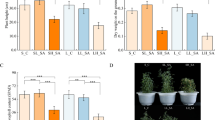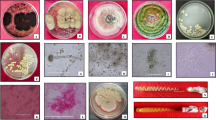Abstract
A culture-independent approach was used to evaluate the bacterial community in rhizospheric and nonrhizospheric soil in which Panax ginseng had grown for 3 years. For each sample, soil was randomly collected from multiple sampling points and mixed thoroughly before genomic DNA extraction. Universal primers 27f and 1492r were used to amplify 16S rRNA genes. Clone libraries were constructed using the amplified 16S rRNA genes, and 192 white clones were chosen for further sequencing. After digestion with restriction endonuclease, 44 operational taxonomic units (OTUs) were generated for rhizospheric and 21 OTUs for nonrhizospheric soils, and the clones of each OTU were sequenced. Blast analysis showed that bacillus, acidobacteria, and proteobacteria were the dominant populations in rhizospheric soil, and proteobacteria were dominant in nonrhizospheric soil. Phylogenetic results showed that bacillus and acidobacteria were clustered into the group of uncultured bacteria in rhizospheric soil; however, proteobacteria were the unique dominant in nonrhizospheric soil.





Similar content being viewed by others
References
Anderson IC, Cairney JWG (2004) Diversity and ecology of soil fungal communities: increased understanding through the application of molecular techniques. Environ Microbiol 6:769–779
Baik KS, Park SC, Kim EM, Bae KS, Ahn JH, Ka JO, Chun J, Seong CN (2008) Diversity of bacterial community in freshwater of woopo wetland. J Microbiol 46:647–655
Bais HP, Weir TL, Perry LG, Gilroy S, Vivanco JM (2006) The role of root exudates in rhizosphere interactions with plants and other organisms. Annu Rev Plant Biol 57:233–266
Bertin C, Yang XH, Weston LA (2003) The role of root exudates and allelochemicals in the rhizosphere. Plant Soil 256:67–83
Deng W, Xi D, Mao H, Wanapat M (2008) The use of molecular techniques based on ribosomal RNA and DNA for rumen microbial ecosystem studies: a review. Mol Biol Rep 35:265–274
Enkerli J, Widmer F (2010) Molecular ecology of fungal entomopathogens: molecular genetic tools and their applications in population and fate studies. Biocontrol 55:17–37
Felsenstein J (1985) Confidence limits on phylogenies: an approach using the bootstrap. Evolution 39:783–791
Garbeva P, van Veen JA, van Elsas JD (2004) Microbial diversity in soil: selection of microbial populations by plant and soil type and implications for disease suppressiveness. Annu Rev Phytopathol 42:243–270
Good IJ (1953) The population frequencies of species and the estimation of population parameters. Biometrika 40:237–262
Gurtler V, Stanisich VA (1996) New approaches to typing and identification of bacteria using the 16S–23S rDNA spacer region. Microbiology 142:3–16
Han LL, Wang ET, Lu YL, Zhang YF, Sui XH, Chen WF, Chen WX (2009) Bradyrhizobium spp. and Sinorhizobium fredii are predominant in root nodules of Vigna angularis, a native legume crop in the subtropical region of China. J Microbiol 47:287–296
Heck KL, Van Belle G, Simberloff D (1975) Explicit calculation of the rarefaction diversity measurement and the determination of sufficient sample size. Ecology 56:1459–1461
Hurlbert SH (1971) The nonconcept of species diversity: a critique and alternative parameters. Ecology 52:577–586
Inceoglu O, Hoogwout EF, Hill P, van Elsas JD (2010) Effect of DNA extraction method on the apparent microbial diversity of soil. Appl Environ Microbiol 76:3378–3382
Jin H, Yu SL, Cao ZQ (2006) Improvement of long-cultivated land of ginseng and farmland for continuous cultivation of ginseng and quinquefolium. World Sci Technol 8:84–87 (Chinese with English abstract)
Jung JD, Park HW, Hahn Y, Hur CG, In DS, Chung HJ, Liu JR, Choi DW (2003) Discovery of genes for ginsenoside biosynthesis by analysis of ginseng expressed sequence tags. Plant Cell Rep 22:224–230
Kirk JL, Beaudette LA, Hart M, Moutoglis P, Klironomos JN, Lee H, Trevors JT (2004) Methods of studying soil microbial diversity. J Microbiol Methods 58:169–188
Li Y, Liu SL, Yi XX, Fu JF, Ding WL (2009) Dynamic of soil microorganisms from root region of ginseng with different growing years. Agric Sci Technol 10:141–143
Li Y, Ying YX, Zhao DY, Jin S, Ding WL (2010) Genetic diversity analysis on rhizosphere soil microbial population of Panax ginseng and Panax quinquefolium by RAPD. Chin Tradit Herb Drugs 41:1871–1875 (Chinese with English abstract)
Lopes AR, Faria C, Prieto-Fernandez A, Trasar-Cepeda C, Manaia CM, Nunes OC (2011) Comparative study of the microbial diversity of bulk paddy soil of two rice fields subjected to organic and conventional farming. Soil Biol Biochem 43:115–125
Man CX, Wang H, Chen WF, Sui XH, Wang ET, Chen WX (2008) Diverse rhizobia associated with soybean grown in the subtropical and tropical regions of China. Plant Soil 310:77–87
Murphy LL, Lee TJ (2002) Ginseng, sex behavior, and nitric oxide. Ann N Y Acad Sci 962:372–377
Mwirichia R, Cousin S, Muigai AW, Boga HI, Stackebrandt E (2010) Archaeal diversity in the Haloalkaline lake elmenteita in Kenya. Curr Microbiol 60:47–52
Nannipieri P, Ascher J, Ceccherini MT, Landi L, Pietramellara G, Renella G (2003) Microbial diversity and soil functions. Eur J Soil Sci 54:655–670
Nocker A, Burr M, Camper AK (2007) Genotypic microbial community profiling: a critical technical review. Microb Ecol 54:276–289
Ntougias S, Kavroulakis N, Papadopoulou KK, Ehaliotis C, Zervakis GI (2010) Characterization of cultivated fungi isolated from grape marc wastes through the use of amplified rDNA restriction analysis and sequencing. J Microbiol 48:297–306
Ofek M, Hadar Y, Minz D (2009) Comparison of effects of compost amendment and of single-strain inoculation on root bacterial communities of young cucumber seedlings. Appl Environ Microbiol 75:6441–6450
Saitou N, Nie M (1987) The Neighbour-joining method: a new method for reconstructing phylogenetic trees. Mol Biol Evol 4:406–425
Scortichini M, Marchesi U, Di Prospero P (2002) Genetic relatedness among Pseudomonas avellanae, P. syringae pv. theae and P.s. pv. actinidiae, and their identification. Eur J Plant Pathol 108:269–278
Sklarz MY, Angel R, Gillor O, Soares MIM (2009) Evaluating amplified rDNA restriction analysis assay for identification of bacterial communities. Antonie Van Leeuwenhoek 96:659–664
Soil Survey Staff (1999) Soil taxonomy. A basic system of soil classification for making and interpreting soil surveys, 2nd edn. U.S. Department of Agriculture, Natural Resources Conservation Service, Washington, DC
Sticher O (1998) Getting to the root of ginseng. ChemTech 28:26–32
Tabacchioni S, Chiarini L, Bevivino A, Cantale C, Dalmastri C (2000) Bias caused by using different isolation media for assessing the genetic diversity of a natural microbial population. Microb Ecol 40:169–176
Tang XM, Gao G, Qin BQ, Zhu LP, Chao JY, Wang JJ, Yang GJ (2009) Characterization of bacterial communities associated with organic aggregates in a large, shallow, eutrophic freshwater lake (Lake Taihu, China). Microb Ecol 58:307–322
Toes ACM, Finke N, Kuenen JG, Muyzer G (2008) Effects of deposition of heavy-metal-polluted harbor mud on microbial diversity and metal resistance in sandy marine sediments. Arch Environ Contam Toxicol 55:372–385
Upadhyay SK, Singh DP, Saikia R (2009) Genetic diversity of plant growth promoting rhizobacteria isolated from rhizospheric soil of wheat under saline condition. Curr Microbiol 59:489–496
Wu LJ, Zhao YH, Guan YM, Pang SF (2008) A review on studies of the reason and control methods of succession cropping obstacle of Panax ginseng C.A. Mey. Special Wild Econ Animal Plant Res 2:68–72 (Chinese with English abstract)
Yang LM, Chen CB, Wang XQ, Zhang LX, Tian YX (2004) Ecological restoration and reused modes of old ginseng land in the Changbai mountainous area and its existing problems. J Jilin Agric Univ 26:546–549 (Chinese with English abstract)
Yeh GY, Eisenberg DM, Kaptchuk TJ, Phillips RS (2003) Systematic review of herbs and dietary supplements for glycemic control in diabetes. Diabetes Care 26:1277–1294
Zhang F, She YH, Ma SS, Hu JM, Banat IM, Hou DJ (2010) Response of microbial community structure to microbial plugging in a mesothermic petroleum reservoir in China. Appl Microbiol Biotechnol 88:1413–1422
Zhao RF (2001) The mechanism of re-plantation problem in ginseng and American ginseng. Special Wild Econ Animal Plant Res 1:40–45 (Chinese with English abstract)
Acknowledgments
This study was supported by the National Natural Science Foundation of China (81072992) and the Doctoral Fund of Ministry of Education of China (200800231060).
Author information
Authors and Affiliations
Corresponding author
Rights and permissions
About this article
Cite this article
Ying, Y.X., Ding, W.L. & Li, Y. Characterization of Soil Bacterial Communities in Rhizospheric and Nonrhizospheric Soil of Panax ginseng . Biochem Genet 50, 848–859 (2012). https://doi.org/10.1007/s10528-012-9525-1
Received:
Accepted:
Published:
Issue Date:
DOI: https://doi.org/10.1007/s10528-012-9525-1




